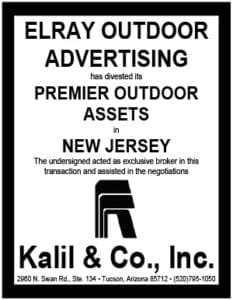 I met Jim Moravec of Stott Outdoor Advertising at the OAAA Legal Seminar last month. As reported in the November 14th edition of Billboard Insider, the homes of several employees of Stott were destroyed by the devastating fires across California, specifically the Camp Fire near the City of Paradise. Now we read about the floods and landslides following the fires in California. Our hearts and prayers are with all of those who suffered through these tragedies.
I met Jim Moravec of Stott Outdoor Advertising at the OAAA Legal Seminar last month. As reported in the November 14th edition of Billboard Insider, the homes of several employees of Stott were destroyed by the devastating fires across California, specifically the Camp Fire near the City of Paradise. Now we read about the floods and landslides following the fires in California. Our hearts and prayers are with all of those who suffered through these tragedies.
These natural disasters remind us that billboards and other forms of out of home advertising are vulnerable, and not only to hurricanes. I’m painfully familiar as a Houstonian with the historical damage caused last year by Hurricane Harvey, most importantly to our residents and their homes of course, but to the outdoor advertising industry as well. It is estimated that thousands of signs worth millions of dollars incurred some degree of damage from Texas to Florida to Puerto Rico by these storms.
Securing governmental permission to repair sign damage, whether caused by storms, fires, mudslides, or even automobile accidents, can be challenging. If the sign conforms to the various height, size, and other regulations currently imposed by the applicable governmental jurisdiction, there should be little if any legal concern over repairing it. Oftentimes jurisdictions require permits to repair conforming signs, so the local building, sign, or other official should be consulted about necessary fees and inspections before proceeding with the sign repairs. However, to the extent repairs are subject to such permit, inspection, and fee requirements, they should be readily authorized for conforming signs, regardless of the degree of damage.
A much more difficult situation is likely to be encountered when the sign is nonconforming. For example, assume the sign was legal, permitted, and complied with all of the regulations of the local jurisdiction when it was constructed. Sometime thereafter, however, the municipality or other regulatory authority amended the sign ordinance, to limit the height or size of signs with specifications that are lower or smaller than the one originally constructed. Or, perhaps the municipality has even passed new regulations that completely prohibit the type of sign originally constructed, such as eliminating pole signs and requiring monument signs, or prohibiting off-premise advertising. These types of regulations passed after the original construction of the sign render it “nonconforming” or “grandfathered,” meaning that it can legally continue to exist despite its failure to comply with the current regulations.
I’ll talk more tomorrow on what to do if your sign is nonconforming.
[wpforms id=”9787″]
Paid Advertisement

















